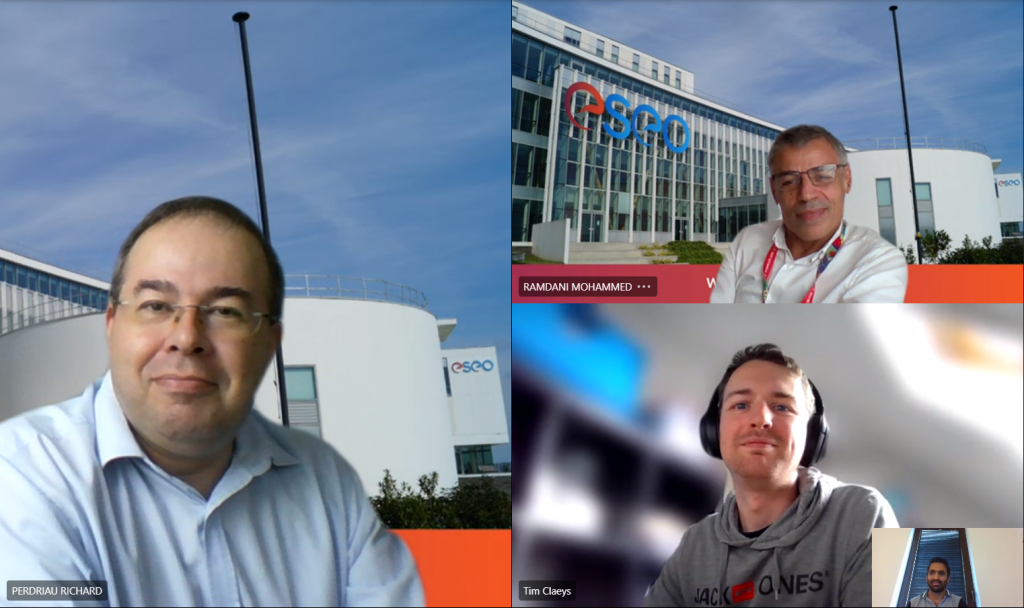As the pandemic heavily disturbed many things around the globe that we found obvious in the past, it also completely turned my secondment plans.
Originally, I had planned a stay at ESEO in Angers (France) for my secondment. I had even booked an apartment and train tickets for the trip, but due to increased coronavirus-restrictions shortly before my departure, we could not do anything other than shift it to an online version. At that moment, I was a bit sad about missing a good opportunity to live in another country and to understand their work environment. However, an online working collaboration also turned out to be a unique and educational experience.
My work revolves around the design of EMI detectors. Such a detector aims to generate a warning when excessive electromagnetic noice disturbs data transmitted through a wired communication channel. So far, I had studied this with simulations. The initial simulations were performed using a simplified mathematical model written in Python. Afterwards, Monte-Carlo based full-wave simulations were used to verify the results in real-like environment. These results have shown that the EMI detector works in most cases, and these results were presented at EMC Europe 2020 and ET 2020. Of course, a physical validation of these sensors is crucial to be sure that indeed they work. And that is the aim of my secondment!
Professor Richard Perdriau and Professor Mohammed Ramdani, both from ESEO were/are my main hosts, during my secondment. For smooth progress of work, meetings were scheduled every Monday for two months using Teams. Both of my supervisors are quite experienced in the design and development electronic PCBA ‘s. The primary objective of my secondment was defined in close collaboration with my main supervisors at KU Leuven, Professor Davy Pissoort and Dr. Tim Claeys. It was decided to develop an actual EMI detector on a printed circuit board (PCB) and validate it using a small stripline set-up, which was already available out my own campus.
Before developing the EMI detector for a wired channel, the wired channel is to be developed. An FPGA was chosen to set up a wired digital channel. We had two options for the EMI detector design. At the one hand, we could decide to use only analogue blocks. At the other hand, we could decide to convert data from analogue to digital form using ADC and then process it using FPGA, which is already present in the channel itself. Although I designed a basic PCB in the past, this proposed design was quite complex, and I had no idea how to deal with it.

The online secondment and the intense guidance from Prof. Richard Perdriau and Prof. Mohammed Ramdani was truly a unique experience for me. During the first month, we focused on the FPGA that should be able to transmit and receive data at a particular frequency. Furthermore, we worked towards a complete conceptual design, which includes the ADC and all its connection to the FPGA.
During the second month of my secondment, we started working on the actual development of the PCB using Altium designer. Professor Richard Perdriau helped me a lot in selecting/using components for our design and also in using Altium and, last but not least, setting it up for the actual PCB design. Unfortunately, in the second half of my secondment, I got infected with the Coronavirus, despites closely following all measures that have been put forward to avoid infections. Luckily I only suffered mild symptoms, limited to slight fever, a cough for a few days, and overall feeling more tired than normal.
As I was previously working on the mathematical model of the EMI detector; I continued working on that by dividing hours of secondment and work along with my work of secondment, in order to maintain the progress. Although I finished the initial PCB design for the EMI detector, I learned from Professor Richard Perdriau that I had made a number of Design/EMI-related design mistakes. Currently, I am working on the latest design using finalized schematic considering all possible EMI-related issues. I hope that my EMI detector will work, and that I will be able to share my results with all of you soon!
Stay safe!
About the Author: Hasan Habib
 Hasan Habib is an early stage researcher of the Pan-European Training, research and education network on Electromagnetic Risk management (PETER). In this project, he will carry out research in the topic “IEC 61508 Hardware Based Techniques & Measures for the EMI Risk Reduction”. More specifically, He will develop EMI sensors that can act as a warning system for impending EMI. This research will be conducted by Hasan in the M-Group at KU Leuven Bruges Campus.
Hasan Habib is an early stage researcher of the Pan-European Training, research and education network on Electromagnetic Risk management (PETER). In this project, he will carry out research in the topic “IEC 61508 Hardware Based Techniques & Measures for the EMI Risk Reduction”. More specifically, He will develop EMI sensors that can act as a warning system for impending EMI. This research will be conducted by Hasan in the M-Group at KU Leuven Bruges Campus.


